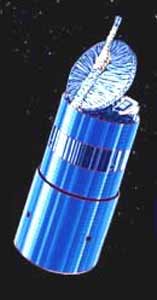Thank you very much for visiting Gunter's Space Page. I hope that this site is useful and informative for you.
If you appreciate the information provided on this site, please consider supporting my work by making a simple and secure donation via PayPal. Please help to run the website and keep everything free of charge. Thank you very much.
Telstar 301, 302, 303 / Arabsat 1E

Telstar 301 [Boeing BSS]
In August 1980, American Telephone and Telegraph Company contracted with Hughes Space and Communications Group for three of the new Telstar-3 satellites, all Hughes HS-376 models. Telstar 3A was launched on a Delta-3920 PAM-D rocket 28 July 1983. Telstar 3C was launched on Shuttle [PAM-D] 30 August 1984, and Telstar 3B was launched on Shuttle [PAM-D] 17 June 1985. The satellites replace those AT&T leased from Comsat General Corporation, a subsidiary of Communications Satellite Corporation. Telstar 3A is in geosynchronous orbit at 96 degrees West longitude, Telstar 3C is at 86 degrees West longitude, and Telstar 3B is at 125 degrees West longitude.
The new satellites have 10 year design lives, as opposed to 7 year lives for earlier satellite models. Life extension is due chiefly to the use of improved nickel-cadmium batteries and the introduction of solid state power amplifiers in place of traveling wave tubes for 18 of the 30 high power transmitters.
The HS-376 spacecraft is spin stabilized, a concept developed at Hughes and used in its communication and scientific satellites for more than 20 years. The HS-376 utilizes two solar cell covered concentric cylinders, of which the outer extends downward in space to greatly increase the solar generating power capacity over the models it replaces. Advanced solar cells made by Spectrolab, a Hughes subsidiary, are used. The solar cells develop 917 Watts at beginning of life. A folding dual reflector, which deploys in space, is located at the forward end of the spacecraft.
The spacecraft is launched with the main communications reflector and the outer cylinder stowed, a configuration that makes it possible to launch either with expendable rocket boosters or from the space shuttle. The compact stowed configuration allows the spacecraft to stand upright in the shuttle cargo bay; occupying a minimum of linear space is a cost effective use of the shuttle.
The spacecraft are 7 feet, 1 inch (2.16 meters) in diameter. In their stowed configuration they are 9 feet (2.74 meters) in height. Height with antennas and the telescoping solar panel deployed is 22 feet, 5 inches (6.84 meters). Weight in orbit is 1438 pounds (653 kg).
Like their predecessor satellites, the Telstar 3 satellites operate at 6/4 GHz (C band). Simultaneous long distance telephone call capacity is 21,600. The satellites furnish voice, video, and high speed data services.
The satellites each have 24 transponder channels that can be switched by ground command to various combinations of regional coverage spanning the continental U.S. and Hawaii, Alaska, or Puerto Rico.
Coverage beams for the Telstar 3 satellites are formed by polarization selective surface reflectors offset by feed horn arrays. One array is for horizontal polarization and the other is for vertical.
The apogee motor that places the satellite into near geosynchronous orbit is a Thiokol Corporation Star-30B solid propellant rocket used on all HS-376 spacecraft.
| Nation: | USA |
|---|---|
| Type / Application: | Communication |
| Operator: | AT&T → Loral Skynet |
| Contractors: | Hughes |
| Equipment: | 24 C-band transponders |
| Configuration: | HS-376 |
| Propulsion: | Star-30B |
| Power: | Solar cells (body mounted and drop-skirt), batteries |
| Lifetime: | 10 years |
| Mass: | 1140 kg (653 kg BOL) |
| Orbit: | GEO |
| Satellite | COSPAR | Date | LS | Launch Vehicle | Remarks | |
|---|---|---|---|---|---|---|
| Telstar 301 → Arabsat 1E | 1983-077A | 28.07.1983 | CC LC-17A | Delta-3920 PAM-D | ||
| Telstar 302 | 1984-093D | 30.08.1984 | CCK LC-39A | Shuttle [PAM-D] | with Discovery F1 (STS 41-D), SBS 4, Leasat 2 | |
| Telstar 303 | 1985-048D | 17.06.1985 | CCK LC-39A | Shuttle [PAM-D] | with Discovery F5 (STS 51-G), Morelos 1, Arabsat 1B, Spartan 101-F1 |
References:
- Boeing: Telstar 3A, 3B, 3C
